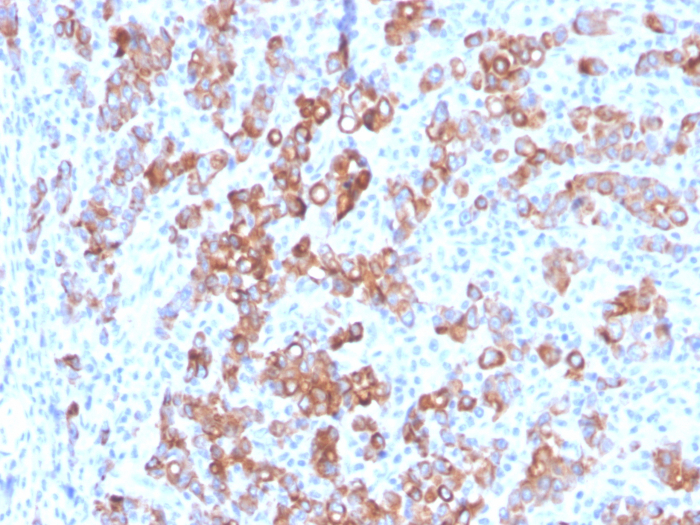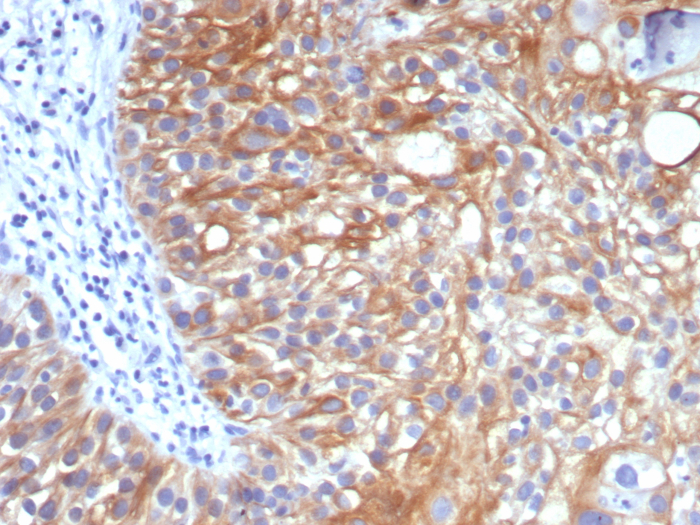TIM-3 Antibody (TIM3/3113) - Azide and BSA Free
Novus Biologicals, part of Bio-Techne | Catalog # NBP2-79836

![Immunohistochemistry-Paraffin: TIM-3 Antibody (TIM3/3113) - Azide and BSA Free [NBP2-79836] Immunohistochemistry-Paraffin: TIM-3 Antibody (TIM3/3113) - Azide and BSA Free [NBP2-79836]](https://resources.bio-techne.com/images/products/TIM-3-Antibody-TIM3-3113-Azide-and-BSA-Free-Immunohistochemistry-Paraffin-NBP2-79836-img0003.jpg)
Conjugate
Catalog #
Key Product Details
Species Reactivity
Human
Applications
ELISA, Immunohistochemistry, Immunohistochemistry-Paraffin, Protein Array
Label
Unconjugated
Antibody Source
Monoclonal Mouse IgG2a Kappa Clone # TIM3/3113
Format
Azide and BSA Free
Concentration
1 mg/ml
Product Specifications
Immunogen
Recombinant fragment of human TIM-3 protein (around aa 22-202) (exact sequence is proprietary) (Uniprot: Q8TDQ0)
Localization
Cell Surface
Marker
Effector T-Cell Marker
Clonality
Monoclonal
Host
Mouse
Isotype
IgG2a Kappa
Theoretical MW
60 kDa.
Disclaimer note: The observed molecular weight of the protein may vary from the listed predicted molecular weight due to post translational modifications, post translation cleavages, relative charges, and other experimental factors.
Disclaimer note: The observed molecular weight of the protein may vary from the listed predicted molecular weight due to post translational modifications, post translation cleavages, relative charges, and other experimental factors.
Description
1.0 mg/ml of antibody purified from Bioreactor Concentrate by Protein A/G. Prepared in 10mM PBS WITHOUT BSA & azide. Also available at 200 ug/ml WITH BSA & azide (NBP2-79702).
Antibody with azide - store at 2 to 8C. Antibody without azide - store at -20 to -80C.
Antibody with azide - store at 2 to 8C. Antibody without azide - store at -20 to -80C.
Scientific Data Images for TIM-3 Antibody (TIM3/3113) - Azide and BSA Free
Immunohistochemistry-Paraffin: TIM-3 Antibody (TIM3/3113) - Azide and BSA Free [NBP2-79836]
Immunohistochemistry-Paraffin: TIM-3 Antibody (TIM3/3113) - Azide and BSA Free [NBP2-79836] - Formalin-fixed, paraffin-embedded human Tonsil stained with TIM-3 Antibody (TIM3/3113).Immunohistochemistry-Paraffin: TIM-3 Antibody (TIM3/3113) - Azide and BSA Free [NBP2-79836]
Immunohistochemistry-Paraffin: TIM-3 Antibody (TIM3/3113) - Azide and BSA Free [NBP2-79836] - Formalin-fixed, paraffin-embedded human Tonsil stained with TIM-3 Antibody (TIM3/3113).Immunohistochemistry-Paraffin: TIM-3 Antibody (TIM3/3113) - Azide and BSA Free [NBP2-79836]
Immunohistochemistry-Paraffin: TIM-3 Antibody (TIM3/3113) - Azide and BSA Free [NBP2-79836] - Formalin-fixed, paraffin-embedded human Adrenal stained with TIM-3 Antibody (TIM3/3113).Applications for TIM-3 Antibody (TIM3/3113) - Azide and BSA Free
Application
Recommended Usage
Immunohistochemistry
1-2 ug/ml
Immunohistochemistry-Paraffin
1-2 ug/ml
Application Notes
ELISA: For coating, order antibody without BSA).
Immunohistochemistry (Formalin-fixed): 1-2ug/ml for 30 min at RT. Staining of formalin-fixed tissues requires heating tissue sections in 10mM Tris with 1mM EDTA, pH 9.0, for 45 min at 95C followed by cooling at RT for 20 minutes.
Optimal dilution for a specific application should be determined.
Immunohistochemistry (Formalin-fixed): 1-2ug/ml for 30 min at RT. Staining of formalin-fixed tissues requires heating tissue sections in 10mM Tris with 1mM EDTA, pH 9.0, for 45 min at 95C followed by cooling at RT for 20 minutes.
Optimal dilution for a specific application should be determined.
Formulation, Preparation, and Storage
Purification
Protein A or G purified
Formulation
10 mM PBS
Format
Azide and BSA Free
Preservative
No Preservative
Concentration
1 mg/ml
Shipping
The product is shipped with polar packs. Upon receipt, store it immediately at the temperature recommended below.
Stability & Storage
Store at -20 to -80C. Avoid freeze-thaw cycles.
Background: TIM-3
Dysregulation of TIM-3 expression is associated with autoimmune diseases as shown by studies where inhibition of TIM-3 using blocking antibodies worsened disease progression in experimental autoimmune encephalomyelitis (EAE) models of multiple sclerosis (MS) (2,3,5). Conversely, high levels of TIM-3 have been shown during viral infection as well as in many cancer types where its increased expression may be an indicator of poor prognosis (2,3,5). TIM-3 has emerged as a potential cancer immunotherapy target as preclinical studies blocking TIM-3 results in increased anti-tumor immunity and prevents tumor growth (3,5). Studies have suggested combination therapy of TIM-3 blockade with blockade of other checkpoint inhibitors such as programmed death 1 (PD-1) or lymphocyte activation gene 3 (LAG-3) is more effective than TIM-3 blockade alone (3,5).
References
1. Acharya N, Sabatos-Peyton C, Anderson AC. Tim-3 finds its place in the cancer immunotherapy landscape. J Immunother Cancer. 2020; 8(1):e000911. https://doi.org/10.1136/jitc-2020-000911
2. Das M, Zhu C, Kuchroo VK. Tim-3 and its role in regulating anti-tumor immunity. Immunol Rev. 2017; 276(1):97-111. https://doi.org/10.1111/imr.12520
3. Joller N, Kuchroo VK. Tim-3, Lag-3, and TIGIT. Curr Top Microbiol Immunol. 2017; 410:127-156. https://doi.org/10.1007/82_2017_62
4. Uniprot (Q8TDQ0)
5. Wolf Y, Anderson AC, Kuchroo VK. TIM3 comes of age as an inhibitory receptor. Nat Rev Immunol. 2020; 20(3):173-185. https://doi.org/10.1038/s41577-019-0224-6
Long Name
T Cell Immunoglobulin Mucin-3
Alternate Names
CD366, HAVcr-2, HAVCR2, KIM-3, SPTCL, TIM3, TIMD3
Gene Symbol
HAVCR2
Additional TIM-3 Products
Product Documents for TIM-3 Antibody (TIM3/3113) - Azide and BSA Free
Product Specific Notices for TIM-3 Antibody (TIM3/3113) - Azide and BSA Free
This product is for research use only and is not approved for use in humans or in clinical diagnosis. Primary Antibodies are guaranteed for 1 year from date of receipt.
Loading...
Loading...
Loading...
Loading...
![Immunohistochemistry-Paraffin: TIM-3 Antibody (TIM3/3113) - Azide and BSA Free [NBP2-79836] Immunohistochemistry-Paraffin: TIM-3 Antibody (TIM3/3113) - Azide and BSA Free [NBP2-79836]](https://resources.bio-techne.com/images/products/TIM-3-Antibody-TIM3-3113-Azide-and-BSA-Free-Immunohistochemistry-Paraffin-NBP2-79836-img0001.jpg)
![Immunohistochemistry-Paraffin: TIM-3 Antibody (TIM3/3113) - Azide and BSA Free [NBP2-79836] Immunohistochemistry-Paraffin: TIM-3 Antibody (TIM3/3113) - Azide and BSA Free [NBP2-79836]](https://resources.bio-techne.com/images/products/TIM-3-Antibody-TIM3-3113-Azide-and-BSA-Free-Immunohistochemistry-Paraffin-NBP2-79836-img0002.jpg)
![Protein Array: TIM-3 Antibody (TIM3/3113) - Azide and BSA Free [NBP2-79836] Protein Array: TIM-3 Antibody (TIM3/3113) - Azide and BSA Free [NBP2-79836]](https://resources.bio-techne.com/images/products/TIM-3-Antibody-TIM3-3113-Azide-and-BSA-Free-Protein-Array-NBP2-79836-img0004.jpg)


![Immunohistochemistry-Paraffin: Mouse Monoclonal TIM-3 Antibody (TIM3/3113) - Azide and BSA Free [NBP2-79836] - TIM-3 Antibody (TIM3/3113) - Azide and BSA Free](https://resources.bio-techne.com/images/products/antibody/nbp2-79836_mouse-monoclonal-tim-3-antibody-tim3-3113-azide-and-bsa-free-immunohistochemistry-paraffin-1122023153926..jpg)